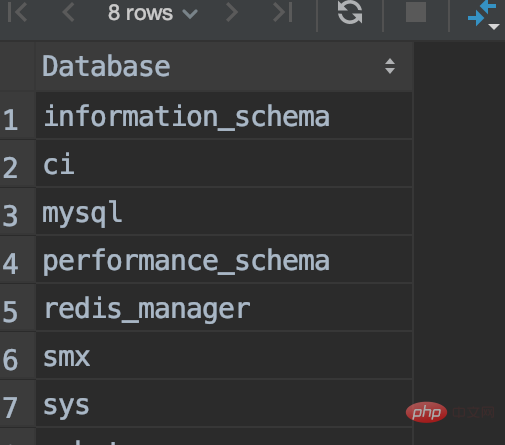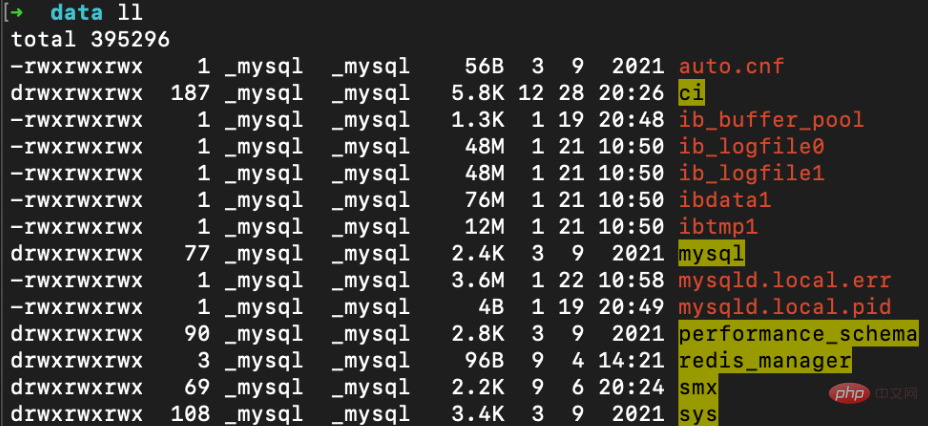How to see where mysql table exists
In mysql, you can use the show statement with datadir to see where the table data is stored. datadir is a system variable corresponding to the data directory. The syntax is "show variables like 'datadir';"; through this command you can View the specific location where the data directory is stored.

The operating environment of this tutorial: windows10 system, mysql8.0.22 version, Dell G3 computer.
How to check where the mysql table exists
We all know that MySQL needs to support persistence. It stores data in the disk. In the operating system, the device that manages the disk is called a file. System, for our research and development, most of us only care about MySQL indexes and SQL performance optimization, but it is like a black box when it comes to how data is stored and where it exists.
1 Data is stored in the file system
Our commonly used storage engine InnoDB stores tables on the file system (i.e. disk). When data needs to be read When, InnoDB will read the data from the file system and return it to us; when data needs to be written, InnoDB will write the data back to the file system, so how is the data of the InnoDB storage engine stored in the file system? Woolen cloth?
2 MySQL data directory
When the MySQL server starts, it will load files from a directory in the file system, and the data generated during runtime will also be written. Stored in this directory of the file system, this directory is the data directory
2.1 Where is the MySQL data directory
The MySQL data directory corresponds to a system variable datadir, which can be passed Command to view the specific location where the data directory is stored:
show variables like 'datadir';
That is to say, the data directory of my local MySQL is in /usr/local/mysql/data/
3 data directory The structure of Data, next, let’s take a closer look at the contents of the data directory~
3.1 Representation of the database in the file systemWhen we execute the create database mydb statement to create a database, MySQL It will do two tasks: Create a folder mydb with the same name as the database name in the data directoryCreate a file named db.opt under mydb. This file contains Various attributes of the database, such as the character set of the database, comparison rules, etc.Currently, by executing the show databases command, you can viewThe databases I created locally include: Then I entered the directory /usr/local/mysql/data/ to see if there are any of the above folders: 
Indeed, the highlighted folders correspond to the databases in MySQL one by one. However, if you look carefully, information_schema does not actually exist. Because it is special, the designers of MySQL have treated its implementation specially, so there is no corresponding database directory. 
mysql video tutorial
The above is the detailed content of How to see where mysql table exists. For more information, please follow other related articles on the PHP Chinese website!

Hot AI Tools

Undresser.AI Undress
AI-powered app for creating realistic nude photos

AI Clothes Remover
Online AI tool for removing clothes from photos.

Undress AI Tool
Undress images for free

Clothoff.io
AI clothes remover

AI Hentai Generator
Generate AI Hentai for free.

Hot Article

Hot Tools

Notepad++7.3.1
Easy-to-use and free code editor

SublimeText3 Chinese version
Chinese version, very easy to use

Zend Studio 13.0.1
Powerful PHP integrated development environment

Dreamweaver CS6
Visual web development tools

SublimeText3 Mac version
God-level code editing software (SublimeText3)

Hot Topics
 PHP's big data structure processing skills
May 08, 2024 am 10:24 AM
PHP's big data structure processing skills
May 08, 2024 am 10:24 AM
Big data structure processing skills: Chunking: Break down the data set and process it in chunks to reduce memory consumption. Generator: Generate data items one by one without loading the entire data set, suitable for unlimited data sets. Streaming: Read files or query results line by line, suitable for large files or remote data. External storage: For very large data sets, store the data in a database or NoSQL.
 How to optimize MySQL query performance in PHP?
Jun 03, 2024 pm 08:11 PM
How to optimize MySQL query performance in PHP?
Jun 03, 2024 pm 08:11 PM
MySQL query performance can be optimized by building indexes that reduce lookup time from linear complexity to logarithmic complexity. Use PreparedStatements to prevent SQL injection and improve query performance. Limit query results and reduce the amount of data processed by the server. Optimize join queries, including using appropriate join types, creating indexes, and considering using subqueries. Analyze queries to identify bottlenecks; use caching to reduce database load; optimize PHP code to minimize overhead.
 How to use MySQL backup and restore in PHP?
Jun 03, 2024 pm 12:19 PM
How to use MySQL backup and restore in PHP?
Jun 03, 2024 pm 12:19 PM
Backing up and restoring a MySQL database in PHP can be achieved by following these steps: Back up the database: Use the mysqldump command to dump the database into a SQL file. Restore database: Use the mysql command to restore the database from SQL files.
 How to insert data into a MySQL table using PHP?
Jun 02, 2024 pm 02:26 PM
How to insert data into a MySQL table using PHP?
Jun 02, 2024 pm 02:26 PM
How to insert data into MySQL table? Connect to the database: Use mysqli to establish a connection to the database. Prepare the SQL query: Write an INSERT statement to specify the columns and values to be inserted. Execute query: Use the query() method to execute the insertion query. If successful, a confirmation message will be output.
 How to fix mysql_native_password not loaded errors on MySQL 8.4
Dec 09, 2024 am 11:42 AM
How to fix mysql_native_password not loaded errors on MySQL 8.4
Dec 09, 2024 am 11:42 AM
One of the major changes introduced in MySQL 8.4 (the latest LTS release as of 2024) is that the "MySQL Native Password" plugin is no longer enabled by default. Further, MySQL 9.0 removes this plugin completely. This change affects PHP and other app
 How to use MySQL stored procedures in PHP?
Jun 02, 2024 pm 02:13 PM
How to use MySQL stored procedures in PHP?
Jun 02, 2024 pm 02:13 PM
To use MySQL stored procedures in PHP: Use PDO or the MySQLi extension to connect to a MySQL database. Prepare the statement to call the stored procedure. Execute the stored procedure. Process the result set (if the stored procedure returns results). Close the database connection.
 How to create a MySQL table using PHP?
Jun 04, 2024 pm 01:57 PM
How to create a MySQL table using PHP?
Jun 04, 2024 pm 01:57 PM
Creating a MySQL table using PHP requires the following steps: Connect to the database. Create the database if it does not exist. Select a database. Create table. Execute the query. Close the connection.
 The difference between oracle database and mysql
May 10, 2024 am 01:54 AM
The difference between oracle database and mysql
May 10, 2024 am 01:54 AM
Oracle database and MySQL are both databases based on the relational model, but Oracle is superior in terms of compatibility, scalability, data types and security; while MySQL focuses on speed and flexibility and is more suitable for small to medium-sized data sets. . ① Oracle provides a wide range of data types, ② provides advanced security features, ③ is suitable for enterprise-level applications; ① MySQL supports NoSQL data types, ② has fewer security measures, and ③ is suitable for small to medium-sized applications.






